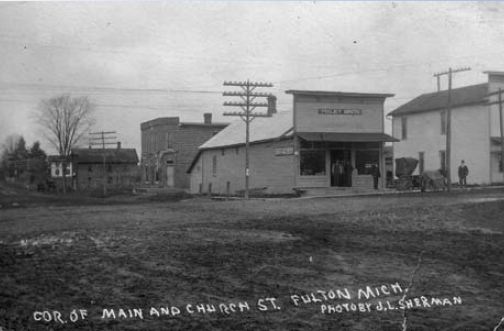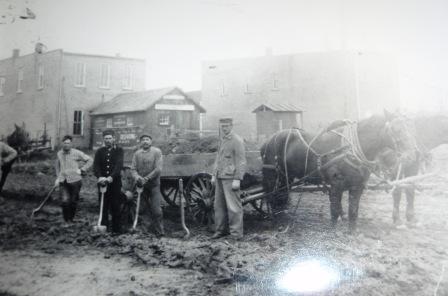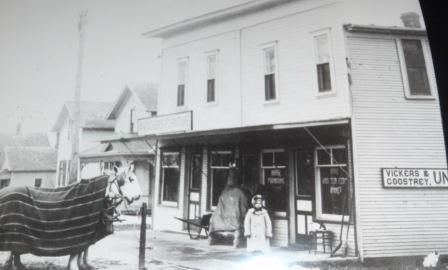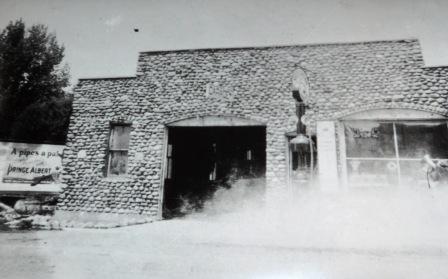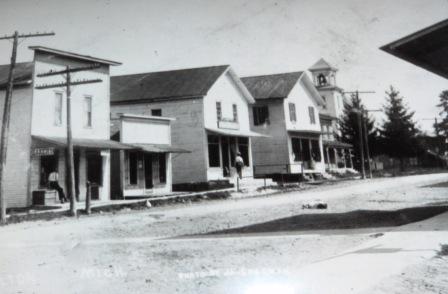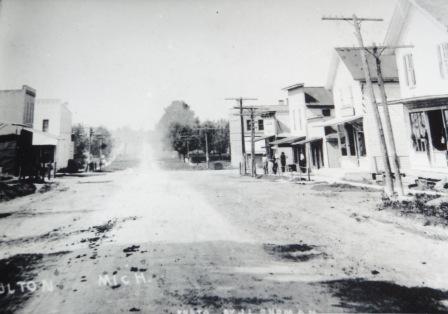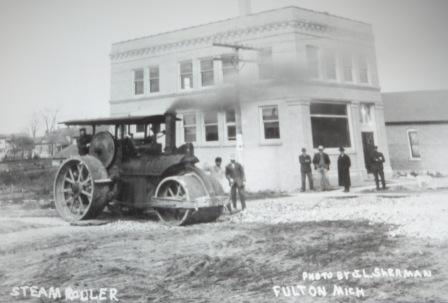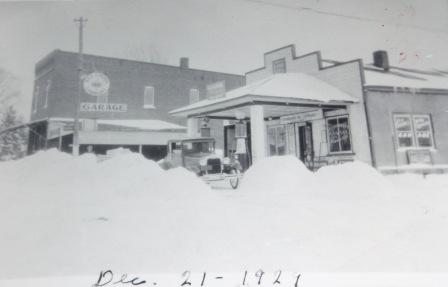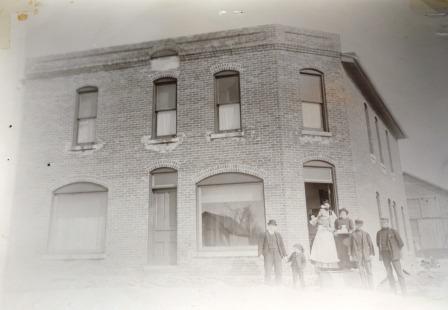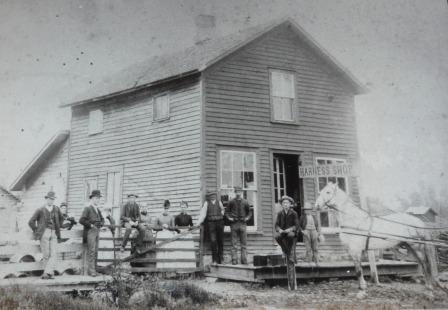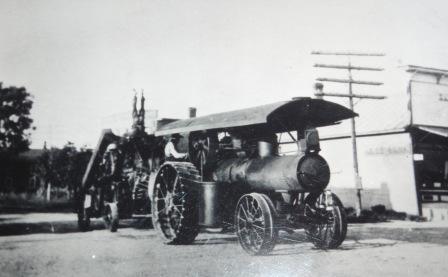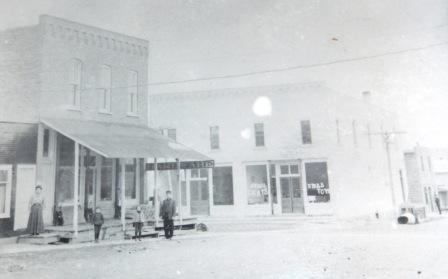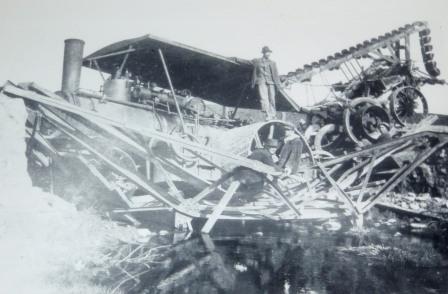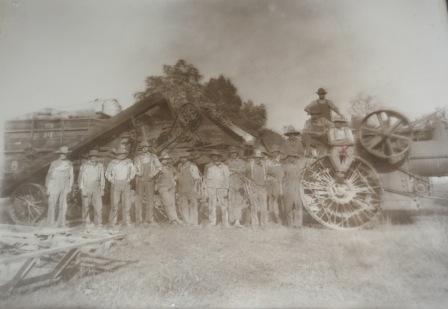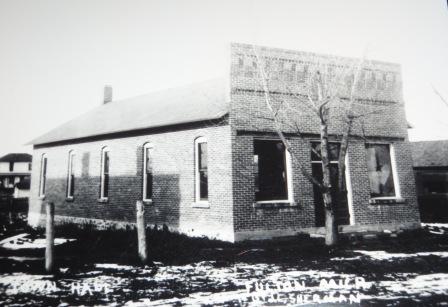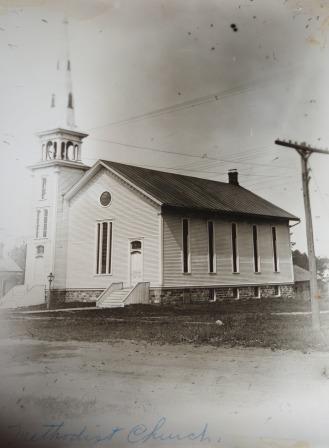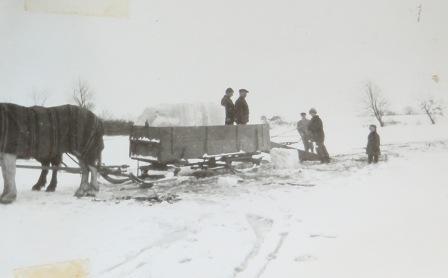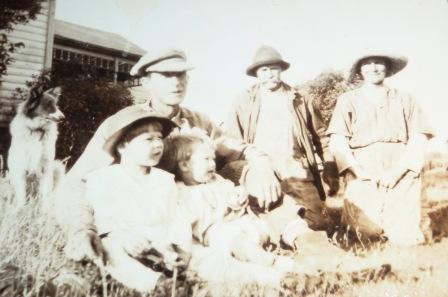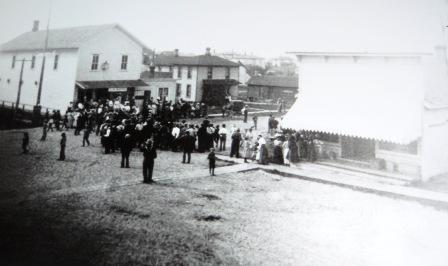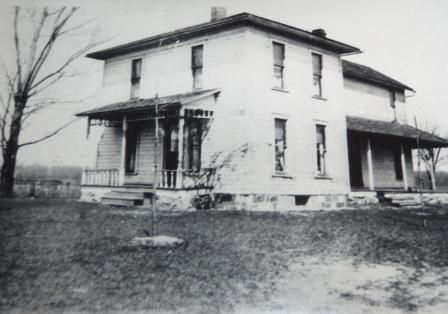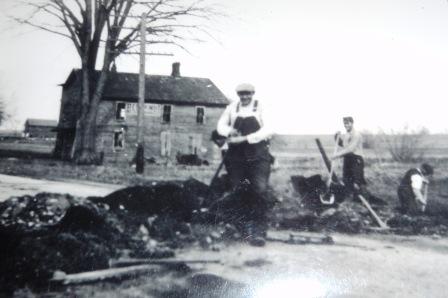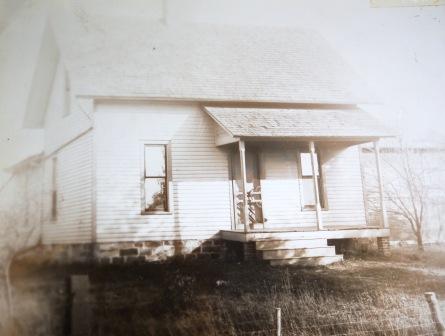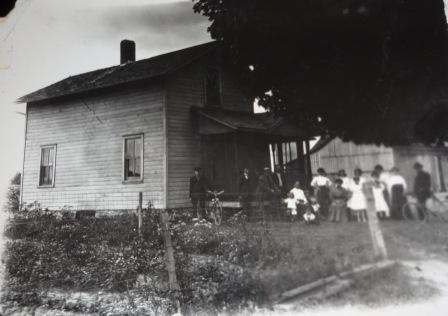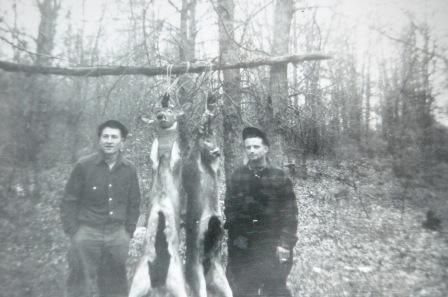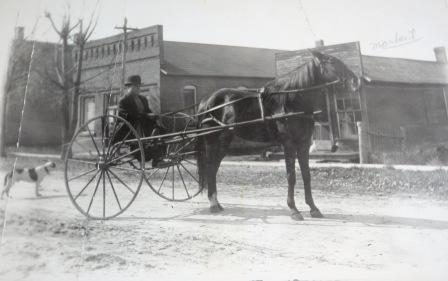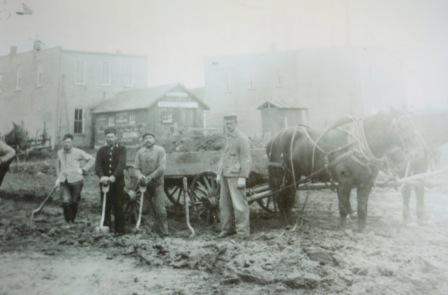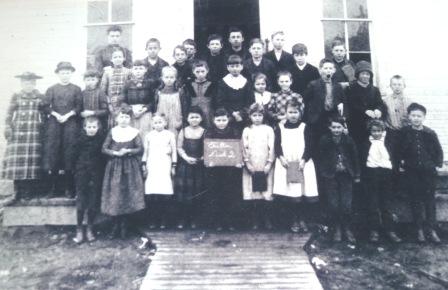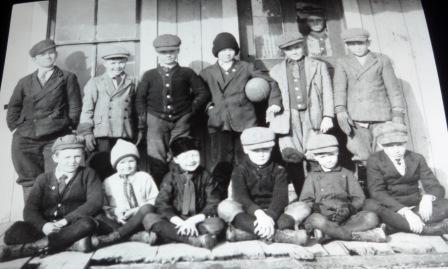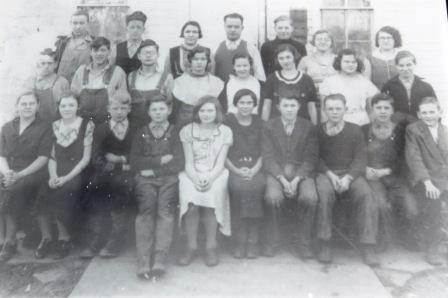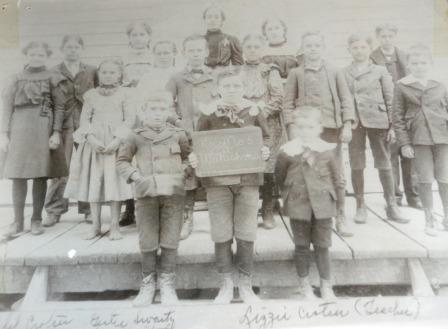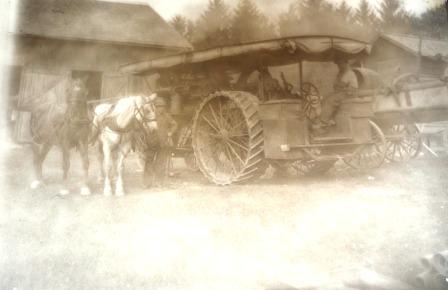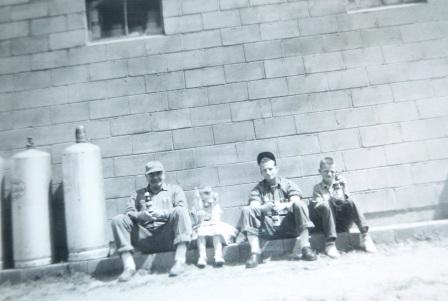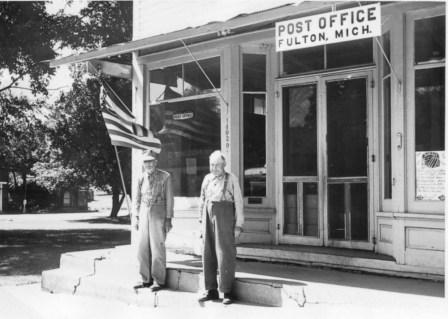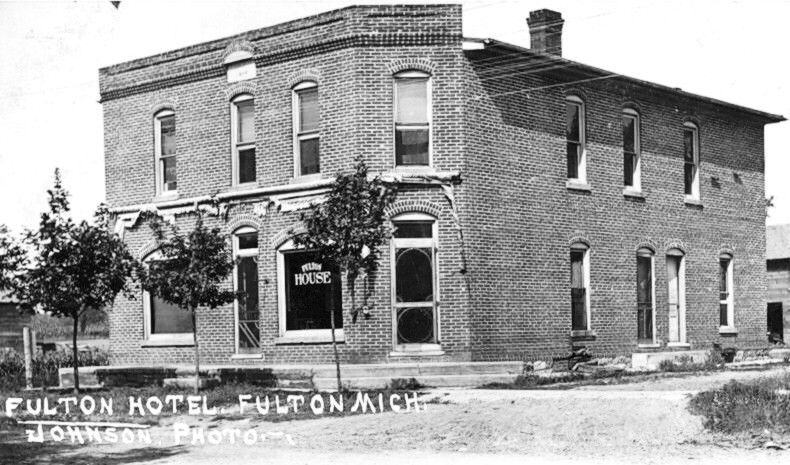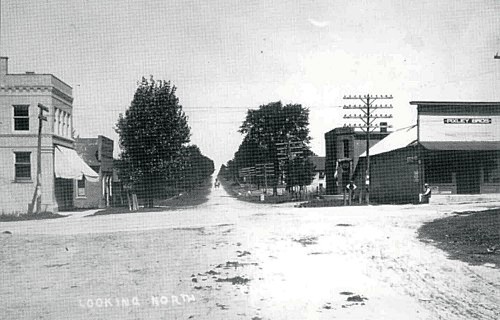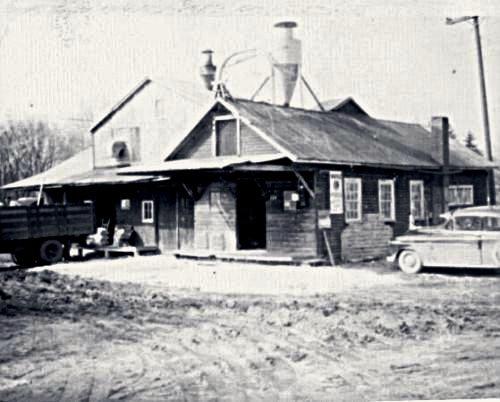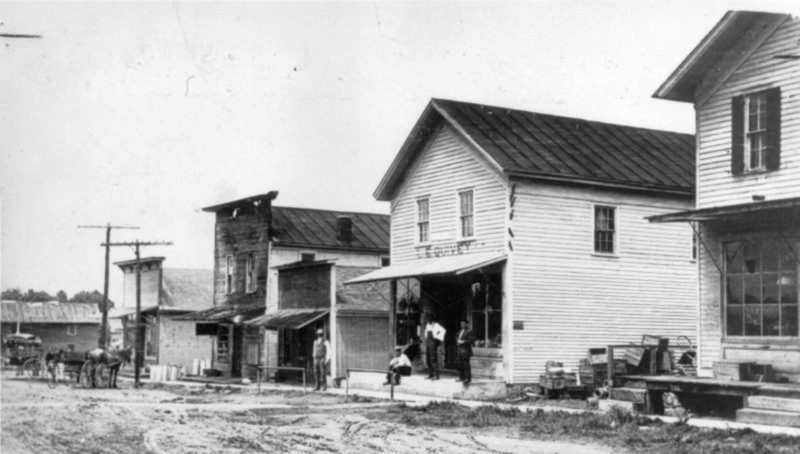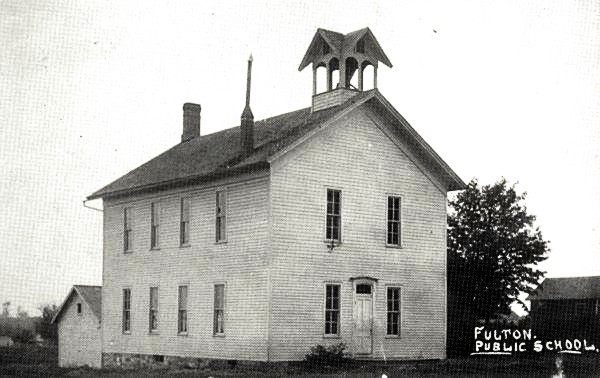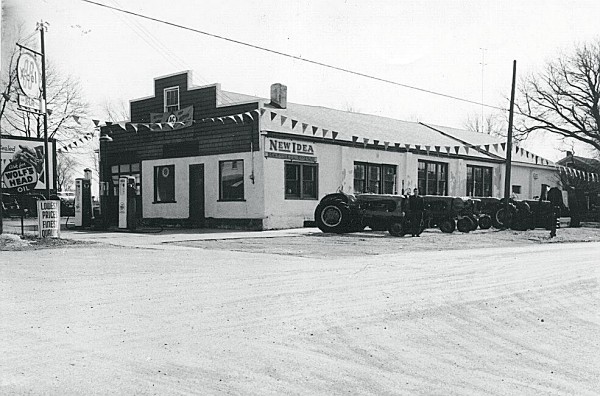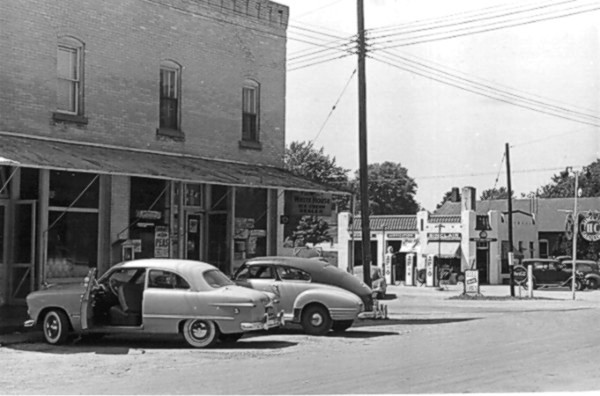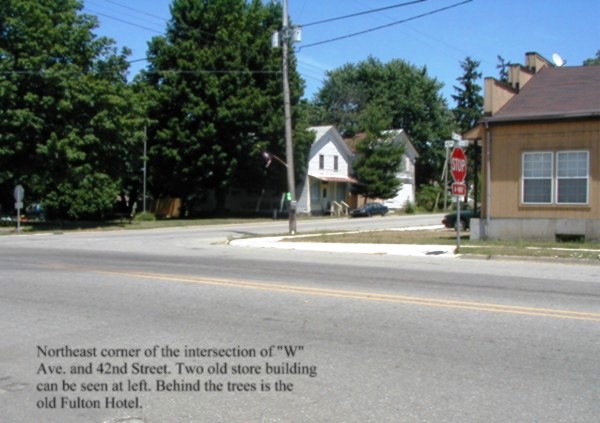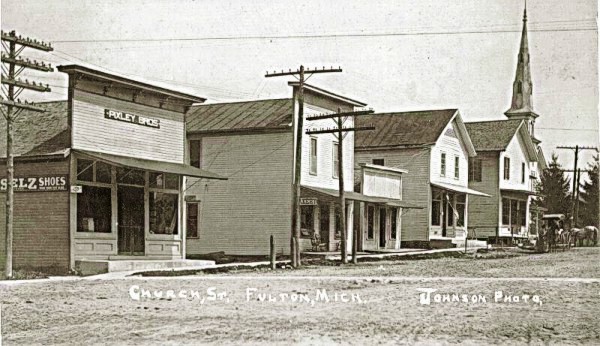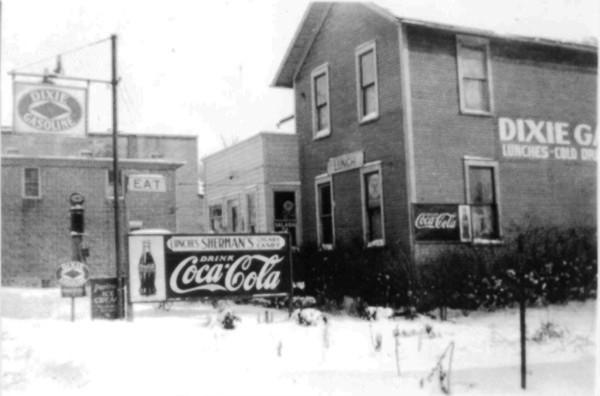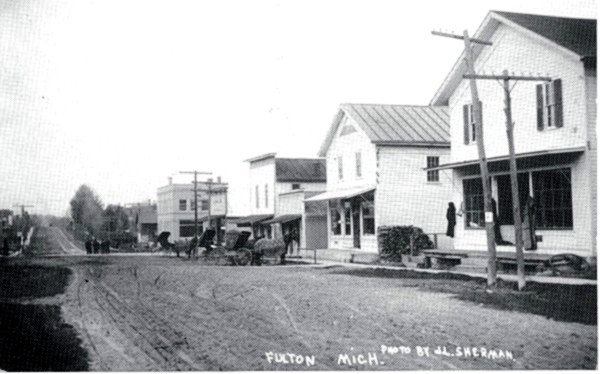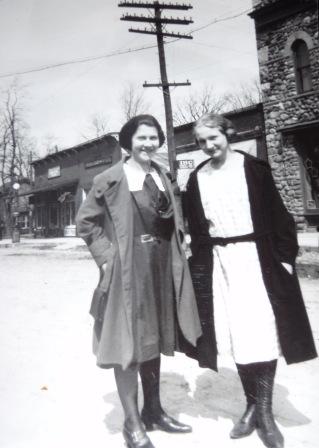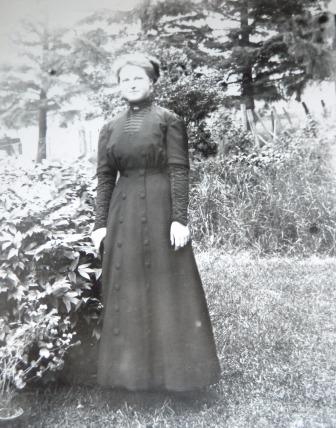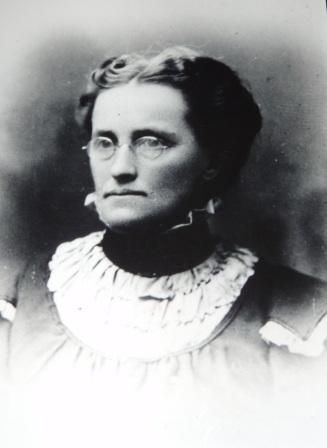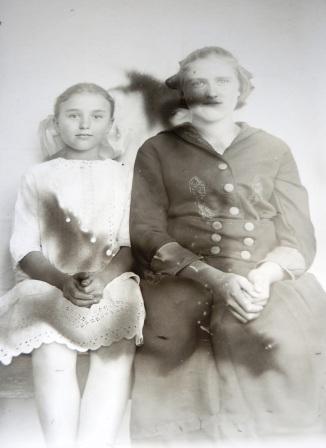Wakeshma Township History
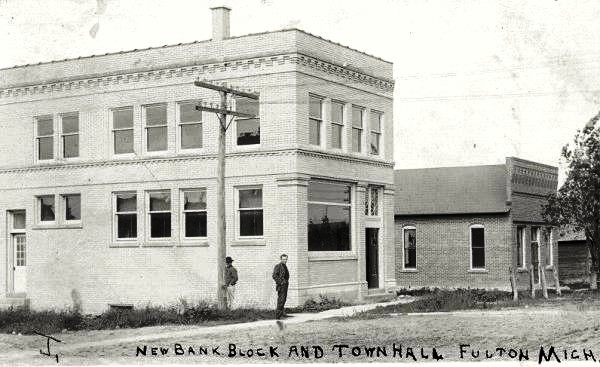
Township Organization
The township was organized March 25, 1846, under the following act: AN ACT to organize certain townships and for other purposes. "All that part of the county of Kalamazoo designated by the United States survey as township number four south, of number nine west, be and the same is hereby set off and organized into a separate township bythe name of Wakeshma, and the first township-meeting shall beheld at the house of Jacob J. Gardner. "Approved March 25, 1846." There was a strong desire expressed on the part of the early settlers to have the township called "Maple," but the Legislature christened it by its present appellation.
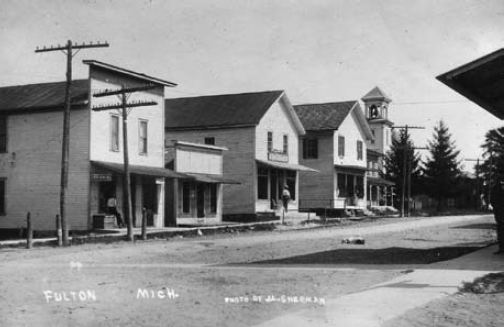
Early Roads
As late as 1846 there was but one road in the township, known as the State road. This road ran on the section line between Sections 7 and 18, on a section line from west to east, and at a distance of a mile and a half from the east line of the township diverged to the north and east. The earliest recorded road, with the exception of the one already mentioned, was surveyed the 13th day of October, 1846, "the whole of which road lies in township 4 south, of range 9 west, to wit: commencing at the quarter stake on the south line of section 5, running thence north three hundred and four rods and twenty links on the quarter line to the point 'where it strikes the town line, it being forty-seven links east of the quarter post at the south side of section 32, in township 3 south, of range 9 west, making in all three hundred and four rods and twenty links. This road is designated as a communicating portion of a road running north and south." The latter road passed through the southern portion of the township of Climax. The survey of this road was made by Randolph Nutting and approved by the highway commissioners, who were Nathan Kerr and Frederick Harrison. The road districts were established by the highway commissioners at a meeting held at the house of J. J. Gardner, March 30, 1847. Other roads were established as the needs of the settlers demanded.
Early Settlers
The earliest settler upon the soil of Wakeshma was Jacob J. Gardner, who first appeared in the township when it was a wilderness and located upon section 15. Finding no neighbors, he was obliged to depend wholly upon his own exertions in his efforts to improve his land and make for himself a comfortable home. He emigrated from Columbia Co., N. Y., and became a resident of the township in 1843. Mr. Gardner's integrity of character and his indomitable will made him one of the most influential of the early pioneers. He was chosen the first supervisor of the township, and from that date until his death held many of the important offices within the gift of the people. His knowledge of parliamentary law and his excellent judgment made his influence important in the administration of public affairs. After a long life of usefulness, his remains sleep in sight of the homestead in which his life had been passed. The following list embraces the tax-payers in Wakeshma for 1846, the year of its organization:
Click here for list of 1846 Tax Payers in Wakeshma.
The next pioneer who cleared the forests of Wakeshma was John Beard, who came from St. Lawrence County, in New York, later in the same year, and purchased 40 acres of Harvey Jaycox, to which he added 80 acres, and later an additional 80, the latter having been purchased of William Beard. Upon Mr. Beard's arrival, he immediately turned his attention to the building of a shelter for his family; which consisted of a log house covered with basswood shakes. Mr. Beard had 12 children, but one of whom was born in the township, and who were on but one occasion together at the same time. His son George still resides in the township. He is known as a successful farmer, and a man of remarkable memory. Leveritt Beard, another son, was the first child born in the township, his birth having occurred in 1844.
Nelson Washburne may be ranked as among the foremost of the early pioneers, having made the township his home in 1842, and entered 80 acres of land in December of that year; this he at once improved and made productive.
The first religious service in the township was held at the log house of Mr. Washburne. Services followed soon after at the house of Jacob J. Gardner, which were led by Edward Chesebro, from Calhoun County. Caleb Orcutt came from Cincinnati in 1837, and entered 160 acres of land on section 34. The date of his settlement it is impossible to give, though he may be ranked among the earliest pioneers. He first filled the office of township clerk, and acted as the second supervisor. His career was, however, brief, as a fatal illness ended his life in 1849, after which his family removed to Minnesota. His son later resumed his residence in the township, and died there in 1872. John Stilwell, with his sons, Elias and David, removed to the township in 1842, when they chose a home on section 8. David removed to section 14, where he purchased 80 acres and still resides. They were among the earliest township officers, and took an active interest in affairs of public import. Joseph Heminway was a resident of the township before its organization, and first filled the office of school inspector. He resided upon 160 acres, which he purchased of Ward & Bronson, who entered it for purposes of speculation, and lived upon thisiand until his death. A. Nutting and his son Randolph were among the earliest purchasers of land in the southwest portion of the township. Randolph Nutting was a surveyor by profession, and the evidences of his professional skill are apparent in every portion of the township. He was a man of scholarly attainments, but eccentric in his tastes, and lived, apart from his neighbors, the life of a hermit. His death occurred in 1879. In 1843, Russell Worden and Charles Carver arrived. They both purchased uncleared land on section 32, which by their energy and industry they converted into productive farms. John D. Kerr was among the early settlers upon section 20. With him came his son Nathan, who, in conjunction with Charles Root, built a saw-mill on section 11, which, though of limited capacity, sawed much of the timber used in that early day. Cornelius Cuyler was one of the pioneers of 1846. He purchased of Stephen Vickery, who had previously entered it, 80 acres on section 12. The township in the immediate vicinity of his purchase was in a very primitive condition at this time. Wolves were abundant, and the game of the forest afforded an easy subsistence to the Indians, whose wigwams were seen at frequent intervals. Mr. Cuyler first built a house of logs and then removed his family to their new habitation. At the expiration of a few years he removed to Athens, where he died. An early festive occasion of some significance in the township was the union of Mr. Cuyler's daughter to Matthew Cullen, the first marriage in Wakeshma. Ass Wixson was one of the pioneers of 1845. He came from Chemung Co., N. Y., and located, in November of that year, 80 acres on section 12. He remained with his family at Athens, with a settler named Doiph. until a log house was constructed, into which they removed on its completion. He then began the clearing of his land, having succeeded in improving ten acres the first winter. The following spring ten additional acres were chopped, half of which was sown with wheat. He became a successful farmer, and died in the township in 1871. His son Ozias has laid claim to his having raised the first wheat in the township, though it is quite probable that a wheat crop was produced earlier than 1846. Augustus B. Scott purchased 80 acres of Ass Briggs, on section 15, in 1846. Mr. Scott was one of the foremost citizens of the township, a man of sound judgment and much force of character. He was the second township clerk, for many years supervisor, and filled other important local offices. His widow still resides upon the homestead. A settler named Valentine, who lived west of Fulton, then known as Wakeshma Centre, died in 1846. A few of the settlers came to the funeral with ox-teams, the place having been reached with difficulty, owing to the want of roads. A prayer was offered on the occasion, but no further service was held. This was the earliest death in the township. John and Matthew Cullen were in the township during the year of its organization, but did not enter land until 1849, in July of which year Matthew purchased 40 acres on section 13. They erected a log house and cleared the land embraced in the purchase, and later sold to Benjamin Atwood. Sylvester Fredenburgh was a former resident of Wayne County, though born in Columbia Co., N. Y. He made Michigan his home in 1852, having purchased 200 acres on section 35. The land was then in a primitive condition, but Mr. Fredenburg's industry soon converted it into productive fields. He immediately built a log shanty, and soon afterwards the first frame barn in the township. The log house not meeting the requirements of his family, he afterwards erected his present spacious residence. This boasted not only a cellar but a cistern, and was altogether the most pretentious residence that appeared in Wakeshma for years. Mr. Fredenburgh was active in the organization of the early school districts, and has, by his well-directed enterprise, been greatly instrumental in the growth and prosperity of the township. The successive years in which he has filled the office of supervisor indicates the confidence manifested by the people in his executive ability. He is a prominent Mason, and has been Worshipful Master of the Wakeshma Lodge from its organization, with the exception of the present year. Mr. Fredenburgh was also instrumental in building the two churches of the township, in one of which he is an active officer. He still resides upon the land he originally purchased. Benjamin Atwood was a pioneer from Steuben Co., N. Y., and early settled in Calhoun Co., Mich. In 1854, being attracted by the superior quality of the land in Wakeshma, he removed thither, and built the Atwood Mills on section 11, which are still running. He also for a brief period kept a store in the vicinity. Mr. Atwood was a man of strong personal traits, and firm in his convictions. His frank expressions of opinion during the war called forth severe judgment from others, but his subsequent course proved these criticisms to be groundless. He died in 1874, on the land he originally purchased. Jeremiah Mears removed to the township in 1854, and has at various times owned many farms within its precincts. He now resides at Fulton. Samuel R. CuIp was the pioneer of a small colony of settlers from Ohio, from whence he came in 1856, and purchased the south half of section 24. This portion of the township was then a wilderness, and Mr. CuIp devoted himself in the spring of his arrival to the clearing of a sufficient portion upon which to erect a log house, to which he removed his family in the fall. He also built a saw-mill the same year, which was run by steam-power, and began operation in December of 1856. This mill was kept actively employed for ten years, and sawed 2,000,000 feet of lumber per year. It was the second saw-mill in the township, the Atwood Mill being the first. For some time after Mr. Cuip's arrival the southeast portion of the township was entirely unsettled, his location being one and a half miles from a road and two miles from the nearest log house. His presence, however, soon attracted a band of settlers from his own State, among whom was Anthony Fritz, who arrived the same fail and purchased a half interest in the mill. George Mason and family and Sidney Draper and family followed soon after and settled on section 25. They all enjoyed the hospitality of Mr. CuIp (27 in number) until they were able to erect houses of their own, the size of this elastic log residence having been 16 by 24 feet. George Mason subsequently removed to section 16, where he still resides. Sidney Draper later emigrated to Kansas. David Kindy was the next Ohio pioneer who selected a home, and now resides on section 24. Mr. CuIp subsequently purchased other lands in the township, and finally removed to Athens, where he is now engaged in mercantile pursuits.
Villages
Fulton-The little hamlet of Fulton, formerly known as Wakeshma Centre, and still designated by that name by many old residents of the township, is located on the four corners of sections 15, 16, 21, and 22. The land, with the exception of the portion on section 16, was entered by Joshua B. Dawkin, Daniel A. Lovett, J. H. Ostrom, W. R. Palmer, and Thomas R. Walker, in March, 1836. These parties bought for speculative purposes, and sold again long before the first log house was erected, or any preliminary steps were taken towards making it the business centre of the township.
The first settler in Fulton was John Y. Lipe, who emigrated from Onondaga Co., N. Y., and purchased 80 acres, a portion of which is now occupied by the hamlet. He first built a log house, and subsequently engaged in the manufacture of shingles, for which the demand was limited, and easily supplied by Mr. Lipe's industry. He afterwards removed to Wexford County, where he now resides.
Nathan Kerr came soon after and bought the half of Lipe's purchase. embracing 40 acres. He was employed in a saw-mill, built on section 11, but resided in the family of Mr. Lipe.
Calvin Frost, who now resides at Fulton, where he owns a productive farm. came from Canada, and was engaged as a contractor on the Michigan Southern Railroad. In the fall of 1851 he pre-empted land on section 26, on which he erected buildings and improved five acres. He subsequently purchased a land-warrant and located 80 acres, embracing his improvements, Nov. 9, 1852. He cultivated the remaining portion, and ultimately removed to his present residence.
Henry Selkrig built a store in 1869, which he filled with a general stock of goods. The building was three stories in height, the remaining portions having been built by the Good Templars and the Masonic lodge. Mr. Selkrig did not, however, remain long, his successors being William Green & Son. They were in turn succeeded by G. O. Byington, who afterwards removed to the store he at present occupies. The building erected by Mr. Selkrig ultimately passed into the hands of the Hon. Zaohariah Chandler.
The hamlet, which in the business season has quite an important trade, has two churches, a flourishing school, taught by Miss Minnie Pierce, two general stores, the proprietors of which are G. O. Byington and Messrs. Culp & Bond, one hardware- and boot- and shoe-store, kept by A. F. Cropsey & Co., a drug-store, owned by O. G. Cook, who is also deputy postmaster (G. P. Mason being the postmaster), a blacksmith-shop, kept by Hakes Brothers, one harnessshop, owned by S. B. Lovin, a wagon-shop, the proprietor of which is G. F. M. Wright, and a boot and shoe-shop, kept by C. Mullen. J. R. Mears carries on a general undertaking business. The place also boasts two physicians, Dr. G. P. Pease, who represents the allopathic, and Dr. W. H. Haskin the homeopathic school.
Churches
Methodist Episcopal.-A class was early organized in Wakeshma, and meetings were held in the school-
house at Wakeshma Centre. The society attained such strength that it was determined, under the ministry of Rev. J. W. Hallowell, in 1871, to erect a house of worship. The work progressed so rapidly that the church was nearly completed the same year, and the following year witnessed the dedicatory services. The pastors in succession since the organization of the society have been:
Revs. Frank Gage, John Clubine, 1854; Noah Fassett, 1855; F. W. Hoag, 1856; -- Ostrom, 1858; -- McCarthy, 1860; J. Gore, 1881; -- Kise, 1862; A. W. Torry, 1864, Wm. Paddock, 1867; C. T. Van Antwerp, 1869; J. W. Hallowell, 1870; J. A. Van Fleet, 1873; J. White, 1875; J. F. Orwick, 1876; W. M. Ball, 1878.
The present stewards are D. J. Fritz, J. Hull, J. McIntire, W. C. Smith, P. Dier, G. W. Brownell, O. M. Gates. The trustees are J. Dir, J. B. Hawks, C. Snell, D. Richards, D. F. Bartsha, J. Tomlinson, S. Vickers, F. Harrison.
Connected with the church is a flourishing Sunday-school, over which W. Mapes is superintendent, who is aided by an efficient corps of teachers.
Evangelical Reformed Church.-This religious society was organized on the 5th of May, 1866. The first officers were George Snyder and John W. Gibson, Elders; Bernard Mathes and Charles C. Cratser, Deacons; H. G. Hess, Treasurer. The first pastor was Rev. Samuel Z. Beam.
The church edifice was commenced in 1869, the cornerstone being laid on the 9th of October in that year. It was completed and dedicated in the following year, 1870. The pastors since the first mentioned have been L. M. Rershner, Samuel Z. Beam, -- Readinger (not installed), Solomon Ream, and D. H. Reiter, the present pastor. The original membership numbered 13.
Schools
The first school-house in the township was built near the log house of J. J. Gardner, some time after his advent. The early teacher in this rudely-constructed building is not remembered by the surviving settlers. Soon after a school was organized embracing the children of the families living on section 32, and a log school-house was built, the first teacher being Miss Crucia Ann Tuttle.
School-houses followed the arrival of settlers until the township is well supplied with means of instruction. There are in Wakeshma 6 whole and.4 fractional school districts, presided over by the following directors; J. G. Wicks, N. R. Wakes, Joseph Crotser, A. S Pomeroy William Culp, Nathan Holcomb, Thomas Copley, J. C. Mears, George Eberstein, and I. F. Alvord. The whole number of pupils receiving instruction is 463, who are taught by 10 male and 11 female teachers The total amount paid them in salaries is $1488.50.
 Wakeshma Facts
Wakeshma Facts
Wakeshma Township was the last township to be politically organized.
The residents would have preferred the township to be named "Maple" because of the extensive maple sugaring in the area.
The meal served at the first township meeting March 25, 1846 was bear meat.
The first business in Fulton was a general store which opened in 1869.
Inventor and surgeon Dr. Homer Stryker the founder of the Stryker Corporation was born in 1894 and lived in Wakeshma Township.
There are currently 1,414 people who live in the township as of 2010 census..
 Historic Photos
Historic Photos
